Preferences for International Airline Carriers Case Study 2022
VerifiedAdded on 2022/10/01
|14
|4328
|52
AI Summary
Contribute Materials
Your contribution can guide someone’s learning journey. Share your
documents today.
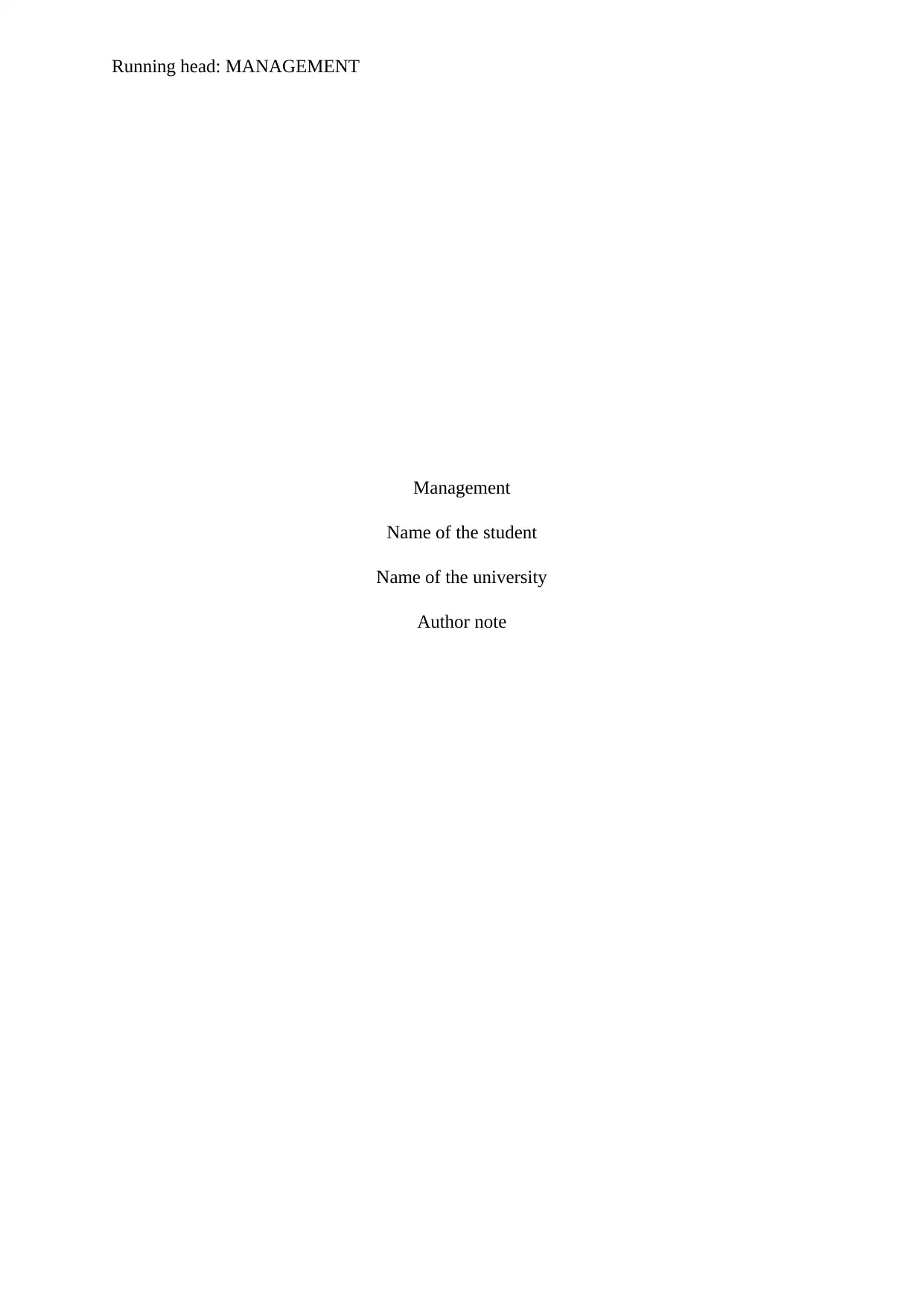
Running head: MANAGEMENT
Management
Name of the student
Name of the university
Author note
Management
Name of the student
Name of the university
Author note
Secure Best Marks with AI Grader
Need help grading? Try our AI Grader for instant feedback on your assignments.
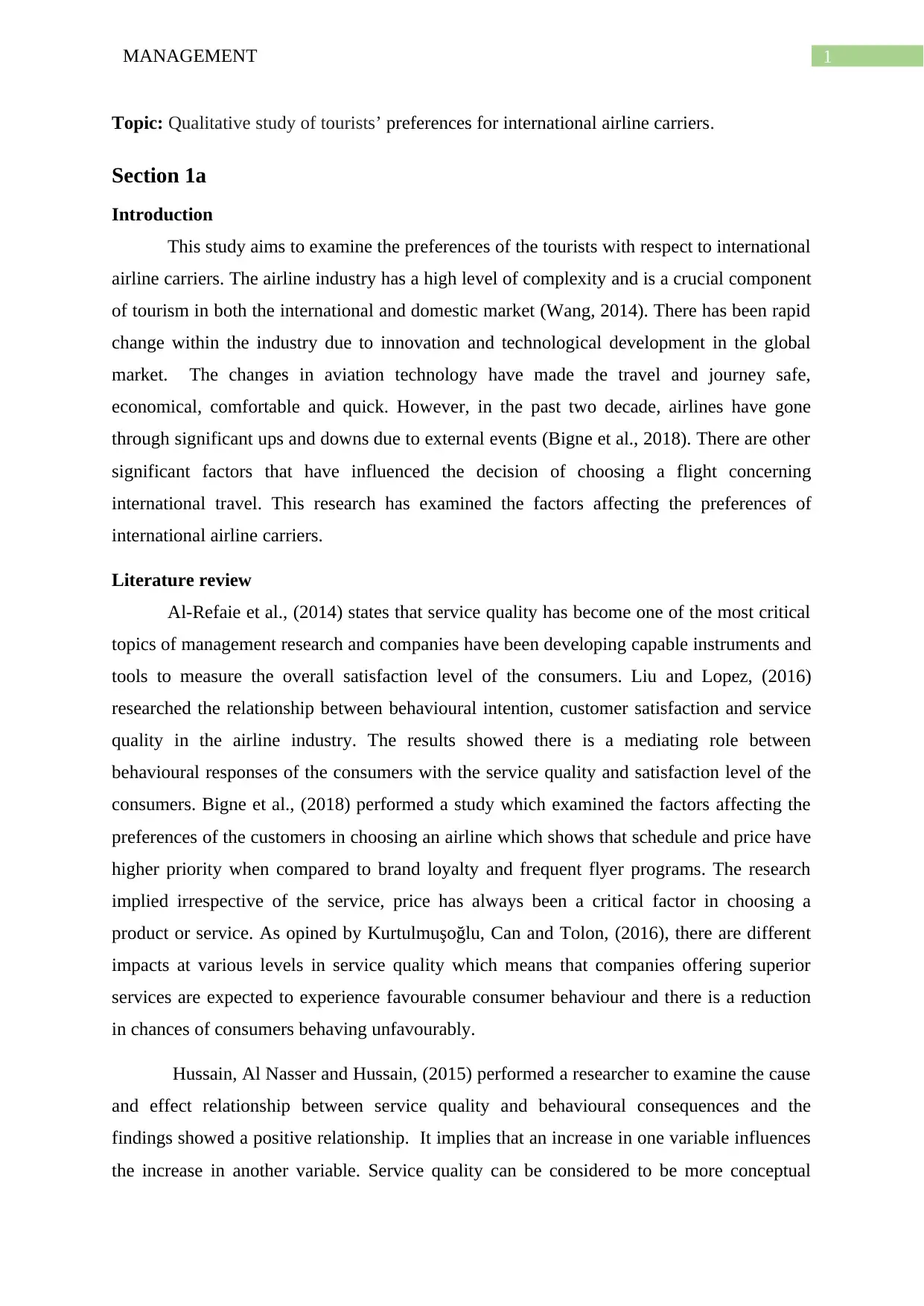
1MANAGEMENT
Topic: Qualitative study of tourists’ preferences for international airline carriers.
Section 1a
Introduction
This study aims to examine the preferences of the tourists with respect to international
airline carriers. The airline industry has a high level of complexity and is a crucial component
of tourism in both the international and domestic market (Wang, 2014). There has been rapid
change within the industry due to innovation and technological development in the global
market. The changes in aviation technology have made the travel and journey safe,
economical, comfortable and quick. However, in the past two decade, airlines have gone
through significant ups and downs due to external events (Bigne et al., 2018). There are other
significant factors that have influenced the decision of choosing a flight concerning
international travel. This research has examined the factors affecting the preferences of
international airline carriers.
Literature review
Al-Refaie et al., (2014) states that service quality has become one of the most critical
topics of management research and companies have been developing capable instruments and
tools to measure the overall satisfaction level of the consumers. Liu and Lopez, (2016)
researched the relationship between behavioural intention, customer satisfaction and service
quality in the airline industry. The results showed there is a mediating role between
behavioural responses of the consumers with the service quality and satisfaction level of the
consumers. Bigne et al., (2018) performed a study which examined the factors affecting the
preferences of the customers in choosing an airline which shows that schedule and price have
higher priority when compared to brand loyalty and frequent flyer programs. The research
implied irrespective of the service, price has always been a critical factor in choosing a
product or service. As opined by Kurtulmuşoğlu, Can and Tolon, (2016), there are different
impacts at various levels in service quality which means that companies offering superior
services are expected to experience favourable consumer behaviour and there is a reduction
in chances of consumers behaving unfavourably.
Hussain, Al Nasser and Hussain, (2015) performed a researcher to examine the cause
and effect relationship between service quality and behavioural consequences and the
findings showed a positive relationship. It implies that an increase in one variable influences
the increase in another variable. Service quality can be considered to be more conceptual
Topic: Qualitative study of tourists’ preferences for international airline carriers.
Section 1a
Introduction
This study aims to examine the preferences of the tourists with respect to international
airline carriers. The airline industry has a high level of complexity and is a crucial component
of tourism in both the international and domestic market (Wang, 2014). There has been rapid
change within the industry due to innovation and technological development in the global
market. The changes in aviation technology have made the travel and journey safe,
economical, comfortable and quick. However, in the past two decade, airlines have gone
through significant ups and downs due to external events (Bigne et al., 2018). There are other
significant factors that have influenced the decision of choosing a flight concerning
international travel. This research has examined the factors affecting the preferences of
international airline carriers.
Literature review
Al-Refaie et al., (2014) states that service quality has become one of the most critical
topics of management research and companies have been developing capable instruments and
tools to measure the overall satisfaction level of the consumers. Liu and Lopez, (2016)
researched the relationship between behavioural intention, customer satisfaction and service
quality in the airline industry. The results showed there is a mediating role between
behavioural responses of the consumers with the service quality and satisfaction level of the
consumers. Bigne et al., (2018) performed a study which examined the factors affecting the
preferences of the customers in choosing an airline which shows that schedule and price have
higher priority when compared to brand loyalty and frequent flyer programs. The research
implied irrespective of the service, price has always been a critical factor in choosing a
product or service. As opined by Kurtulmuşoğlu, Can and Tolon, (2016), there are different
impacts at various levels in service quality which means that companies offering superior
services are expected to experience favourable consumer behaviour and there is a reduction
in chances of consumers behaving unfavourably.
Hussain, Al Nasser and Hussain, (2015) performed a researcher to examine the cause
and effect relationship between service quality and behavioural consequences and the
findings showed a positive relationship. It implies that an increase in one variable influences
the increase in another variable. Service quality can be considered to be more conceptual
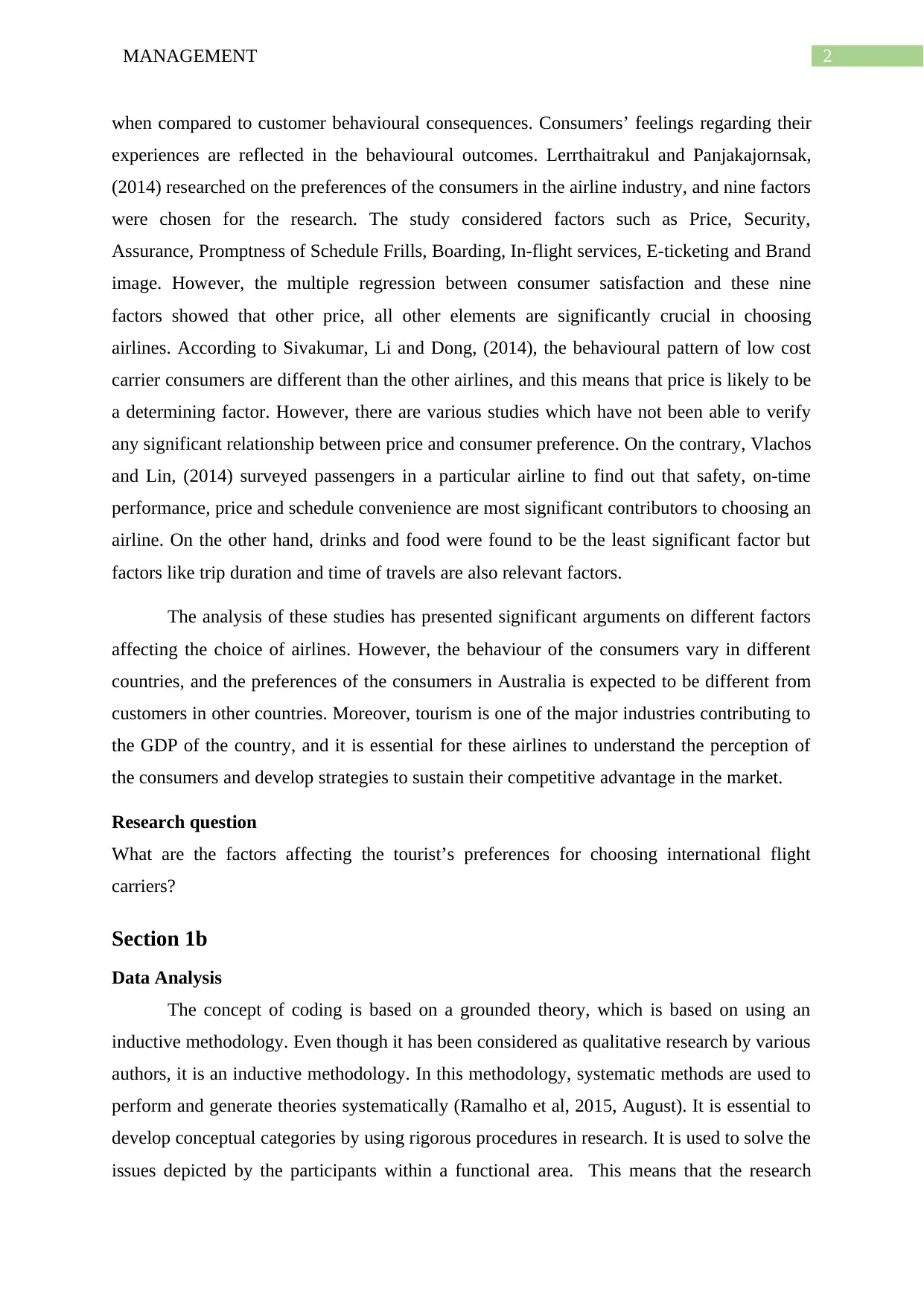
2MANAGEMENT
when compared to customer behavioural consequences. Consumers’ feelings regarding their
experiences are reflected in the behavioural outcomes. Lerrthaitrakul and Panjakajornsak,
(2014) researched on the preferences of the consumers in the airline industry, and nine factors
were chosen for the research. The study considered factors such as Price, Security,
Assurance, Promptness of Schedule Frills, Boarding, In-flight services, E-ticketing and Brand
image. However, the multiple regression between consumer satisfaction and these nine
factors showed that other price, all other elements are significantly crucial in choosing
airlines. According to Sivakumar, Li and Dong, (2014), the behavioural pattern of low cost
carrier consumers are different than the other airlines, and this means that price is likely to be
a determining factor. However, there are various studies which have not been able to verify
any significant relationship between price and consumer preference. On the contrary, Vlachos
and Lin, (2014) surveyed passengers in a particular airline to find out that safety, on-time
performance, price and schedule convenience are most significant contributors to choosing an
airline. On the other hand, drinks and food were found to be the least significant factor but
factors like trip duration and time of travels are also relevant factors.
The analysis of these studies has presented significant arguments on different factors
affecting the choice of airlines. However, the behaviour of the consumers vary in different
countries, and the preferences of the consumers in Australia is expected to be different from
customers in other countries. Moreover, tourism is one of the major industries contributing to
the GDP of the country, and it is essential for these airlines to understand the perception of
the consumers and develop strategies to sustain their competitive advantage in the market.
Research question
What are the factors affecting the tourist’s preferences for choosing international flight
carriers?
Section 1b
Data Analysis
The concept of coding is based on a grounded theory, which is based on using an
inductive methodology. Even though it has been considered as qualitative research by various
authors, it is an inductive methodology. In this methodology, systematic methods are used to
perform and generate theories systematically (Ramalho et al, 2015, August). It is essential to
develop conceptual categories by using rigorous procedures in research. It is used to solve the
issues depicted by the participants within a functional area. This means that the research
when compared to customer behavioural consequences. Consumers’ feelings regarding their
experiences are reflected in the behavioural outcomes. Lerrthaitrakul and Panjakajornsak,
(2014) researched on the preferences of the consumers in the airline industry, and nine factors
were chosen for the research. The study considered factors such as Price, Security,
Assurance, Promptness of Schedule Frills, Boarding, In-flight services, E-ticketing and Brand
image. However, the multiple regression between consumer satisfaction and these nine
factors showed that other price, all other elements are significantly crucial in choosing
airlines. According to Sivakumar, Li and Dong, (2014), the behavioural pattern of low cost
carrier consumers are different than the other airlines, and this means that price is likely to be
a determining factor. However, there are various studies which have not been able to verify
any significant relationship between price and consumer preference. On the contrary, Vlachos
and Lin, (2014) surveyed passengers in a particular airline to find out that safety, on-time
performance, price and schedule convenience are most significant contributors to choosing an
airline. On the other hand, drinks and food were found to be the least significant factor but
factors like trip duration and time of travels are also relevant factors.
The analysis of these studies has presented significant arguments on different factors
affecting the choice of airlines. However, the behaviour of the consumers vary in different
countries, and the preferences of the consumers in Australia is expected to be different from
customers in other countries. Moreover, tourism is one of the major industries contributing to
the GDP of the country, and it is essential for these airlines to understand the perception of
the consumers and develop strategies to sustain their competitive advantage in the market.
Research question
What are the factors affecting the tourist’s preferences for choosing international flight
carriers?
Section 1b
Data Analysis
The concept of coding is based on a grounded theory, which is based on using an
inductive methodology. Even though it has been considered as qualitative research by various
authors, it is an inductive methodology. In this methodology, systematic methods are used to
perform and generate theories systematically (Ramalho et al, 2015, August). It is essential to
develop conceptual categories by using rigorous procedures in research. It is used to solve the
issues depicted by the participants within a functional area. This means that the research
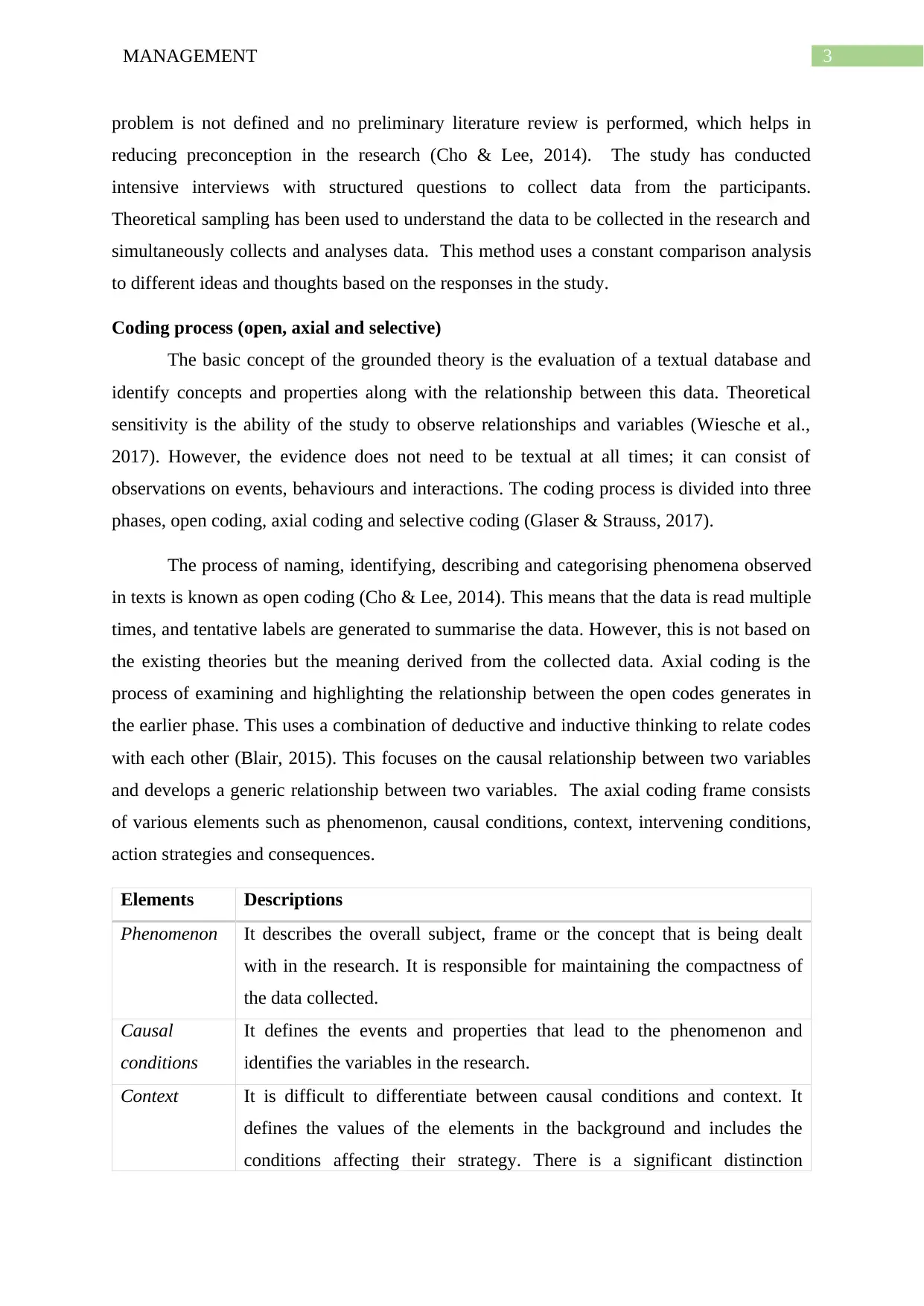
3MANAGEMENT
problem is not defined and no preliminary literature review is performed, which helps in
reducing preconception in the research (Cho & Lee, 2014). The study has conducted
intensive interviews with structured questions to collect data from the participants.
Theoretical sampling has been used to understand the data to be collected in the research and
simultaneously collects and analyses data. This method uses a constant comparison analysis
to different ideas and thoughts based on the responses in the study.
Coding process (open, axial and selective)
The basic concept of the grounded theory is the evaluation of a textual database and
identify concepts and properties along with the relationship between this data. Theoretical
sensitivity is the ability of the study to observe relationships and variables (Wiesche et al.,
2017). However, the evidence does not need to be textual at all times; it can consist of
observations on events, behaviours and interactions. The coding process is divided into three
phases, open coding, axial coding and selective coding (Glaser & Strauss, 2017).
The process of naming, identifying, describing and categorising phenomena observed
in texts is known as open coding (Cho & Lee, 2014). This means that the data is read multiple
times, and tentative labels are generated to summarise the data. However, this is not based on
the existing theories but the meaning derived from the collected data. Axial coding is the
process of examining and highlighting the relationship between the open codes generates in
the earlier phase. This uses a combination of deductive and inductive thinking to relate codes
with each other (Blair, 2015). This focuses on the causal relationship between two variables
and develops a generic relationship between two variables. The axial coding frame consists
of various elements such as phenomenon, causal conditions, context, intervening conditions,
action strategies and consequences.
Elements Descriptions
Phenomenon It describes the overall subject, frame or the concept that is being dealt
with in the research. It is responsible for maintaining the compactness of
the data collected.
Causal
conditions
It defines the events and properties that lead to the phenomenon and
identifies the variables in the research.
Context It is difficult to differentiate between causal conditions and context. It
defines the values of the elements in the background and includes the
conditions affecting their strategy. There is a significant distinction
problem is not defined and no preliminary literature review is performed, which helps in
reducing preconception in the research (Cho & Lee, 2014). The study has conducted
intensive interviews with structured questions to collect data from the participants.
Theoretical sampling has been used to understand the data to be collected in the research and
simultaneously collects and analyses data. This method uses a constant comparison analysis
to different ideas and thoughts based on the responses in the study.
Coding process (open, axial and selective)
The basic concept of the grounded theory is the evaluation of a textual database and
identify concepts and properties along with the relationship between this data. Theoretical
sensitivity is the ability of the study to observe relationships and variables (Wiesche et al.,
2017). However, the evidence does not need to be textual at all times; it can consist of
observations on events, behaviours and interactions. The coding process is divided into three
phases, open coding, axial coding and selective coding (Glaser & Strauss, 2017).
The process of naming, identifying, describing and categorising phenomena observed
in texts is known as open coding (Cho & Lee, 2014). This means that the data is read multiple
times, and tentative labels are generated to summarise the data. However, this is not based on
the existing theories but the meaning derived from the collected data. Axial coding is the
process of examining and highlighting the relationship between the open codes generates in
the earlier phase. This uses a combination of deductive and inductive thinking to relate codes
with each other (Blair, 2015). This focuses on the causal relationship between two variables
and develops a generic relationship between two variables. The axial coding frame consists
of various elements such as phenomenon, causal conditions, context, intervening conditions,
action strategies and consequences.
Elements Descriptions
Phenomenon It describes the overall subject, frame or the concept that is being dealt
with in the research. It is responsible for maintaining the compactness of
the data collected.
Causal
conditions
It defines the events and properties that lead to the phenomenon and
identifies the variables in the research.
Context It is difficult to differentiate between causal conditions and context. It
defines the values of the elements in the background and includes the
conditions affecting their strategy. There is a significant distinction
Secure Best Marks with AI Grader
Need help grading? Try our AI Grader for instant feedback on your assignments.
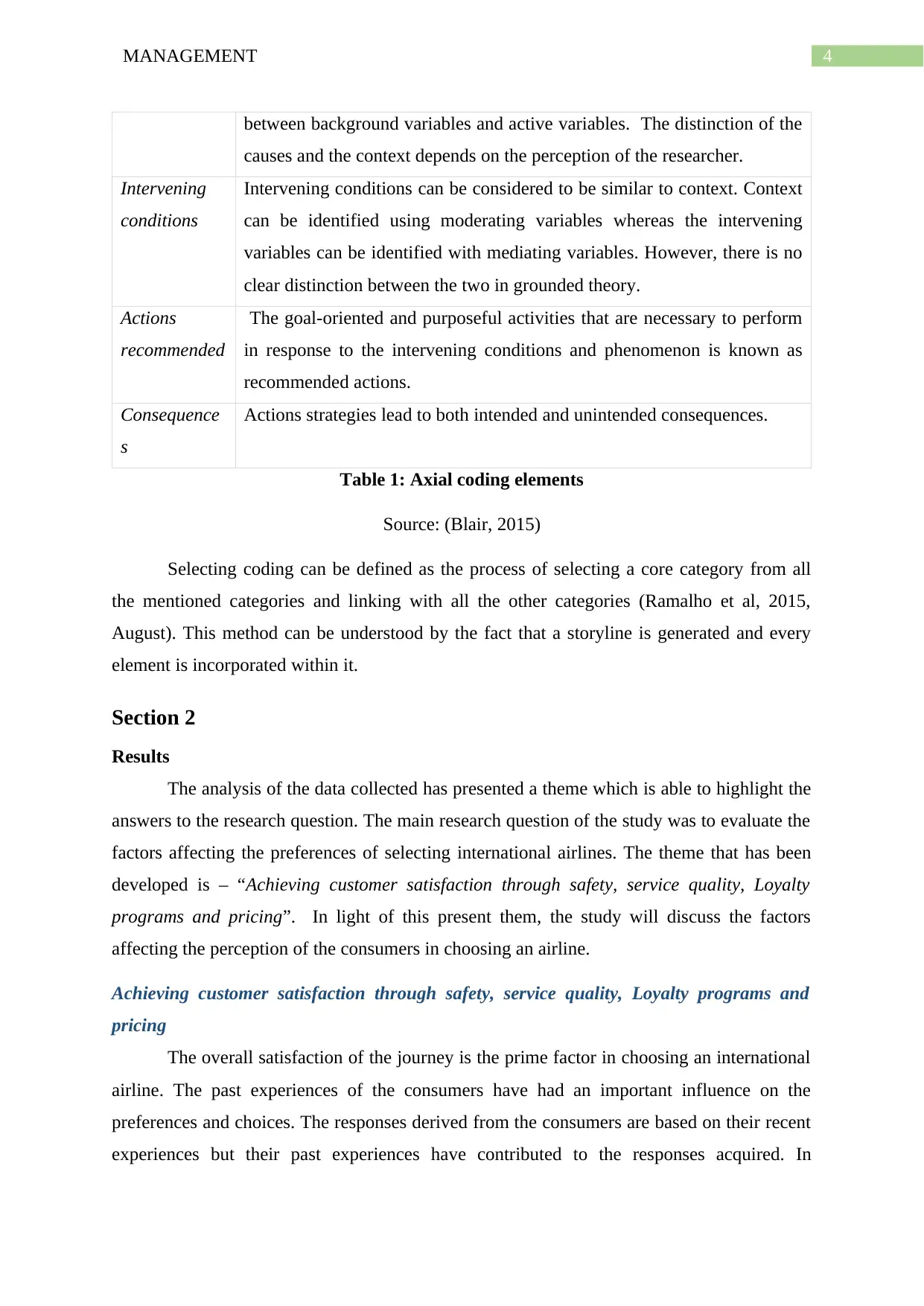
4MANAGEMENT
between background variables and active variables. The distinction of the
causes and the context depends on the perception of the researcher.
Intervening
conditions
Intervening conditions can be considered to be similar to context. Context
can be identified using moderating variables whereas the intervening
variables can be identified with mediating variables. However, there is no
clear distinction between the two in grounded theory.
Actions
recommended
The goal-oriented and purposeful activities that are necessary to perform
in response to the intervening conditions and phenomenon is known as
recommended actions.
Consequence
s
Actions strategies lead to both intended and unintended consequences.
Table 1: Axial coding elements
Source: (Blair, 2015)
Selecting coding can be defined as the process of selecting a core category from all
the mentioned categories and linking with all the other categories (Ramalho et al, 2015,
August). This method can be understood by the fact that a storyline is generated and every
element is incorporated within it.
Section 2
Results
The analysis of the data collected has presented a theme which is able to highlight the
answers to the research question. The main research question of the study was to evaluate the
factors affecting the preferences of selecting international airlines. The theme that has been
developed is – “Achieving customer satisfaction through safety, service quality, Loyalty
programs and pricing”. In light of this present them, the study will discuss the factors
affecting the perception of the consumers in choosing an airline.
Achieving customer satisfaction through safety, service quality, Loyalty programs and
pricing
The overall satisfaction of the journey is the prime factor in choosing an international
airline. The past experiences of the consumers have had an important influence on the
preferences and choices. The responses derived from the consumers are based on their recent
experiences but their past experiences have contributed to the responses acquired. In
between background variables and active variables. The distinction of the
causes and the context depends on the perception of the researcher.
Intervening
conditions
Intervening conditions can be considered to be similar to context. Context
can be identified using moderating variables whereas the intervening
variables can be identified with mediating variables. However, there is no
clear distinction between the two in grounded theory.
Actions
recommended
The goal-oriented and purposeful activities that are necessary to perform
in response to the intervening conditions and phenomenon is known as
recommended actions.
Consequence
s
Actions strategies lead to both intended and unintended consequences.
Table 1: Axial coding elements
Source: (Blair, 2015)
Selecting coding can be defined as the process of selecting a core category from all
the mentioned categories and linking with all the other categories (Ramalho et al, 2015,
August). This method can be understood by the fact that a storyline is generated and every
element is incorporated within it.
Section 2
Results
The analysis of the data collected has presented a theme which is able to highlight the
answers to the research question. The main research question of the study was to evaluate the
factors affecting the preferences of selecting international airlines. The theme that has been
developed is – “Achieving customer satisfaction through safety, service quality, Loyalty
programs and pricing”. In light of this present them, the study will discuss the factors
affecting the perception of the consumers in choosing an airline.
Achieving customer satisfaction through safety, service quality, Loyalty programs and
pricing
The overall satisfaction of the journey is the prime factor in choosing an international
airline. The past experiences of the consumers have had an important influence on the
preferences and choices. The responses derived from the consumers are based on their recent
experiences but their past experiences have contributed to the responses acquired. In
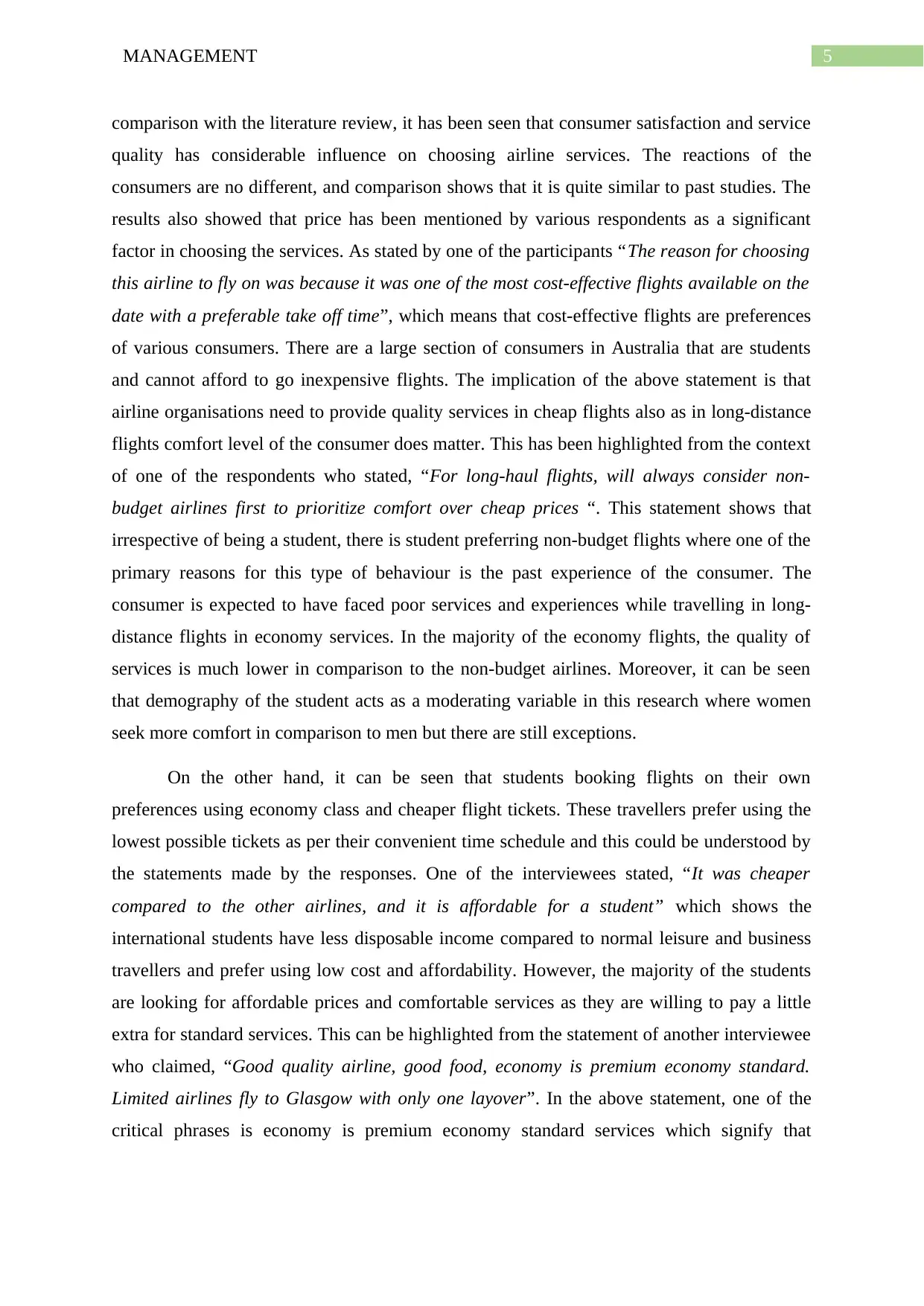
5MANAGEMENT
comparison with the literature review, it has been seen that consumer satisfaction and service
quality has considerable influence on choosing airline services. The reactions of the
consumers are no different, and comparison shows that it is quite similar to past studies. The
results also showed that price has been mentioned by various respondents as a significant
factor in choosing the services. As stated by one of the participants “The reason for choosing
this airline to fly on was because it was one of the most cost-effective flights available on the
date with a preferable take off time”, which means that cost-effective flights are preferences
of various consumers. There are a large section of consumers in Australia that are students
and cannot afford to go inexpensive flights. The implication of the above statement is that
airline organisations need to provide quality services in cheap flights also as in long-distance
flights comfort level of the consumer does matter. This has been highlighted from the context
of one of the respondents who stated, “For long-haul flights, will always consider non-
budget airlines first to prioritize comfort over cheap prices “. This statement shows that
irrespective of being a student, there is student preferring non-budget flights where one of the
primary reasons for this type of behaviour is the past experience of the consumer. The
consumer is expected to have faced poor services and experiences while travelling in long-
distance flights in economy services. In the majority of the economy flights, the quality of
services is much lower in comparison to the non-budget airlines. Moreover, it can be seen
that demography of the student acts as a moderating variable in this research where women
seek more comfort in comparison to men but there are still exceptions.
On the other hand, it can be seen that students booking flights on their own
preferences using economy class and cheaper flight tickets. These travellers prefer using the
lowest possible tickets as per their convenient time schedule and this could be understood by
the statements made by the responses. One of the interviewees stated, “It was cheaper
compared to the other airlines, and it is affordable for a student” which shows the
international students have less disposable income compared to normal leisure and business
travellers and prefer using low cost and affordability. However, the majority of the students
are looking for affordable prices and comfortable services as they are willing to pay a little
extra for standard services. This can be highlighted from the statement of another interviewee
who claimed, “Good quality airline, good food, economy is premium economy standard.
Limited airlines fly to Glasgow with only one layover”. In the above statement, one of the
critical phrases is economy is premium economy standard services which signify that
comparison with the literature review, it has been seen that consumer satisfaction and service
quality has considerable influence on choosing airline services. The reactions of the
consumers are no different, and comparison shows that it is quite similar to past studies. The
results also showed that price has been mentioned by various respondents as a significant
factor in choosing the services. As stated by one of the participants “The reason for choosing
this airline to fly on was because it was one of the most cost-effective flights available on the
date with a preferable take off time”, which means that cost-effective flights are preferences
of various consumers. There are a large section of consumers in Australia that are students
and cannot afford to go inexpensive flights. The implication of the above statement is that
airline organisations need to provide quality services in cheap flights also as in long-distance
flights comfort level of the consumer does matter. This has been highlighted from the context
of one of the respondents who stated, “For long-haul flights, will always consider non-
budget airlines first to prioritize comfort over cheap prices “. This statement shows that
irrespective of being a student, there is student preferring non-budget flights where one of the
primary reasons for this type of behaviour is the past experience of the consumer. The
consumer is expected to have faced poor services and experiences while travelling in long-
distance flights in economy services. In the majority of the economy flights, the quality of
services is much lower in comparison to the non-budget airlines. Moreover, it can be seen
that demography of the student acts as a moderating variable in this research where women
seek more comfort in comparison to men but there are still exceptions.
On the other hand, it can be seen that students booking flights on their own
preferences using economy class and cheaper flight tickets. These travellers prefer using the
lowest possible tickets as per their convenient time schedule and this could be understood by
the statements made by the responses. One of the interviewees stated, “It was cheaper
compared to the other airlines, and it is affordable for a student” which shows the
international students have less disposable income compared to normal leisure and business
travellers and prefer using low cost and affordability. However, the majority of the students
are looking for affordable prices and comfortable services as they are willing to pay a little
extra for standard services. This can be highlighted from the statement of another interviewee
who claimed, “Good quality airline, good food, economy is premium economy standard.
Limited airlines fly to Glasgow with only one layover”. In the above statement, one of the
critical phrases is economy is premium economy standard services which signify that
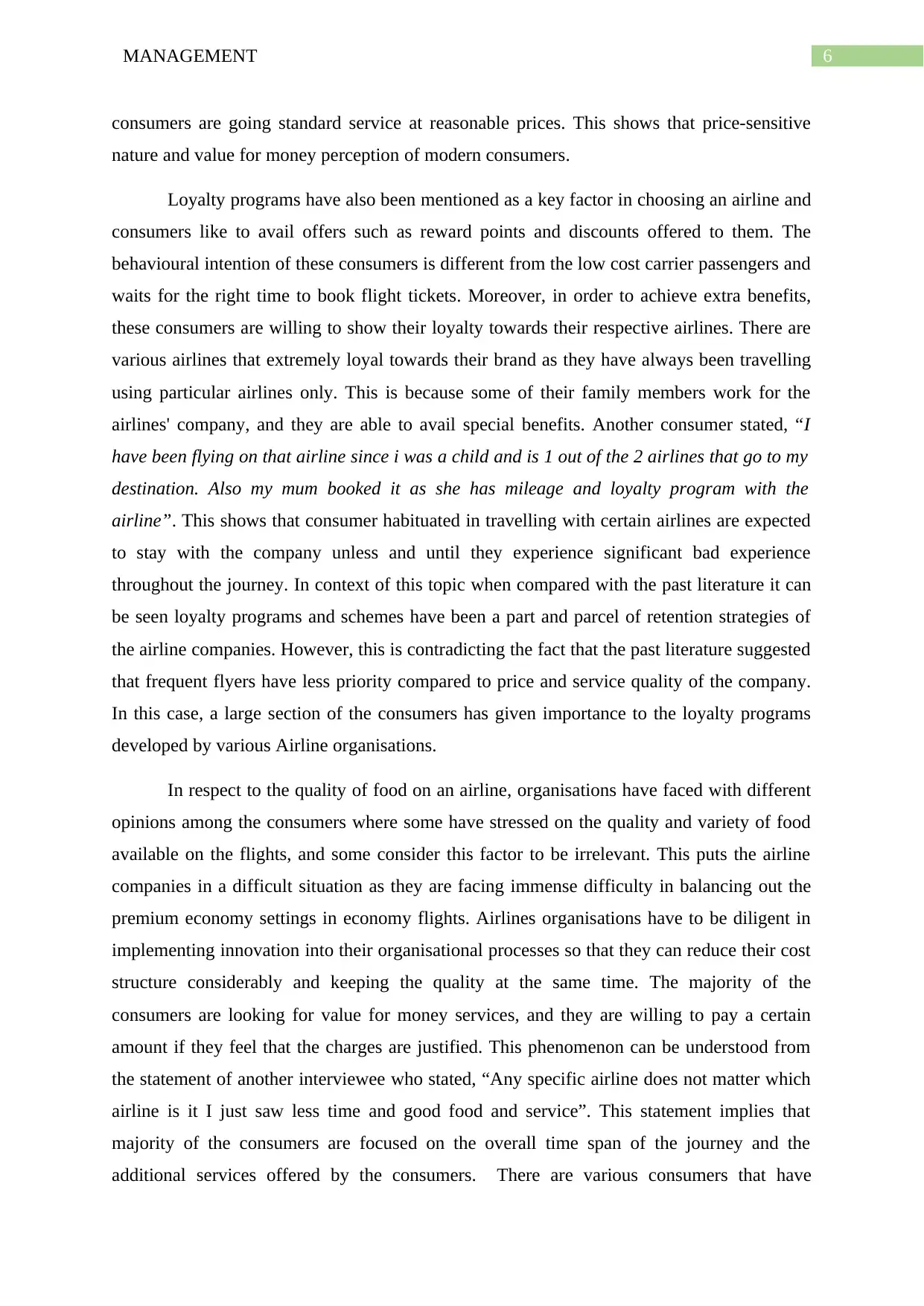
6MANAGEMENT
consumers are going standard service at reasonable prices. This shows that price-sensitive
nature and value for money perception of modern consumers.
Loyalty programs have also been mentioned as a key factor in choosing an airline and
consumers like to avail offers such as reward points and discounts offered to them. The
behavioural intention of these consumers is different from the low cost carrier passengers and
waits for the right time to book flight tickets. Moreover, in order to achieve extra benefits,
these consumers are willing to show their loyalty towards their respective airlines. There are
various airlines that extremely loyal towards their brand as they have always been travelling
using particular airlines only. This is because some of their family members work for the
airlines' company, and they are able to avail special benefits. Another consumer stated, “I
have been flying on that airline since i was a child and is 1 out of the 2 airlines that go to my
destination. Also my mum booked it as she has mileage and loyalty program with the
airline”. This shows that consumer habituated in travelling with certain airlines are expected
to stay with the company unless and until they experience significant bad experience
throughout the journey. In context of this topic when compared with the past literature it can
be seen loyalty programs and schemes have been a part and parcel of retention strategies of
the airline companies. However, this is contradicting the fact that the past literature suggested
that frequent flyers have less priority compared to price and service quality of the company.
In this case, a large section of the consumers has given importance to the loyalty programs
developed by various Airline organisations.
In respect to the quality of food on an airline, organisations have faced with different
opinions among the consumers where some have stressed on the quality and variety of food
available on the flights, and some consider this factor to be irrelevant. This puts the airline
companies in a difficult situation as they are facing immense difficulty in balancing out the
premium economy settings in economy flights. Airlines organisations have to be diligent in
implementing innovation into their organisational processes so that they can reduce their cost
structure considerably and keeping the quality at the same time. The majority of the
consumers are looking for value for money services, and they are willing to pay a certain
amount if they feel that the charges are justified. This phenomenon can be understood from
the statement of another interviewee who stated, “Any specific airline does not matter which
airline is it I just saw less time and good food and service”. This statement implies that
majority of the consumers are focused on the overall time span of the journey and the
additional services offered by the consumers. There are various consumers that have
consumers are going standard service at reasonable prices. This shows that price-sensitive
nature and value for money perception of modern consumers.
Loyalty programs have also been mentioned as a key factor in choosing an airline and
consumers like to avail offers such as reward points and discounts offered to them. The
behavioural intention of these consumers is different from the low cost carrier passengers and
waits for the right time to book flight tickets. Moreover, in order to achieve extra benefits,
these consumers are willing to show their loyalty towards their respective airlines. There are
various airlines that extremely loyal towards their brand as they have always been travelling
using particular airlines only. This is because some of their family members work for the
airlines' company, and they are able to avail special benefits. Another consumer stated, “I
have been flying on that airline since i was a child and is 1 out of the 2 airlines that go to my
destination. Also my mum booked it as she has mileage and loyalty program with the
airline”. This shows that consumer habituated in travelling with certain airlines are expected
to stay with the company unless and until they experience significant bad experience
throughout the journey. In context of this topic when compared with the past literature it can
be seen loyalty programs and schemes have been a part and parcel of retention strategies of
the airline companies. However, this is contradicting the fact that the past literature suggested
that frequent flyers have less priority compared to price and service quality of the company.
In this case, a large section of the consumers has given importance to the loyalty programs
developed by various Airline organisations.
In respect to the quality of food on an airline, organisations have faced with different
opinions among the consumers where some have stressed on the quality and variety of food
available on the flights, and some consider this factor to be irrelevant. This puts the airline
companies in a difficult situation as they are facing immense difficulty in balancing out the
premium economy settings in economy flights. Airlines organisations have to be diligent in
implementing innovation into their organisational processes so that they can reduce their cost
structure considerably and keeping the quality at the same time. The majority of the
consumers are looking for value for money services, and they are willing to pay a certain
amount if they feel that the charges are justified. This phenomenon can be understood from
the statement of another interviewee who stated, “Any specific airline does not matter which
airline is it I just saw less time and good food and service”. This statement implies that
majority of the consumers are focused on the overall time span of the journey and the
additional services offered by the consumers. There are various consumers that have
Paraphrase This Document
Need a fresh take? Get an instant paraphrase of this document with our AI Paraphraser
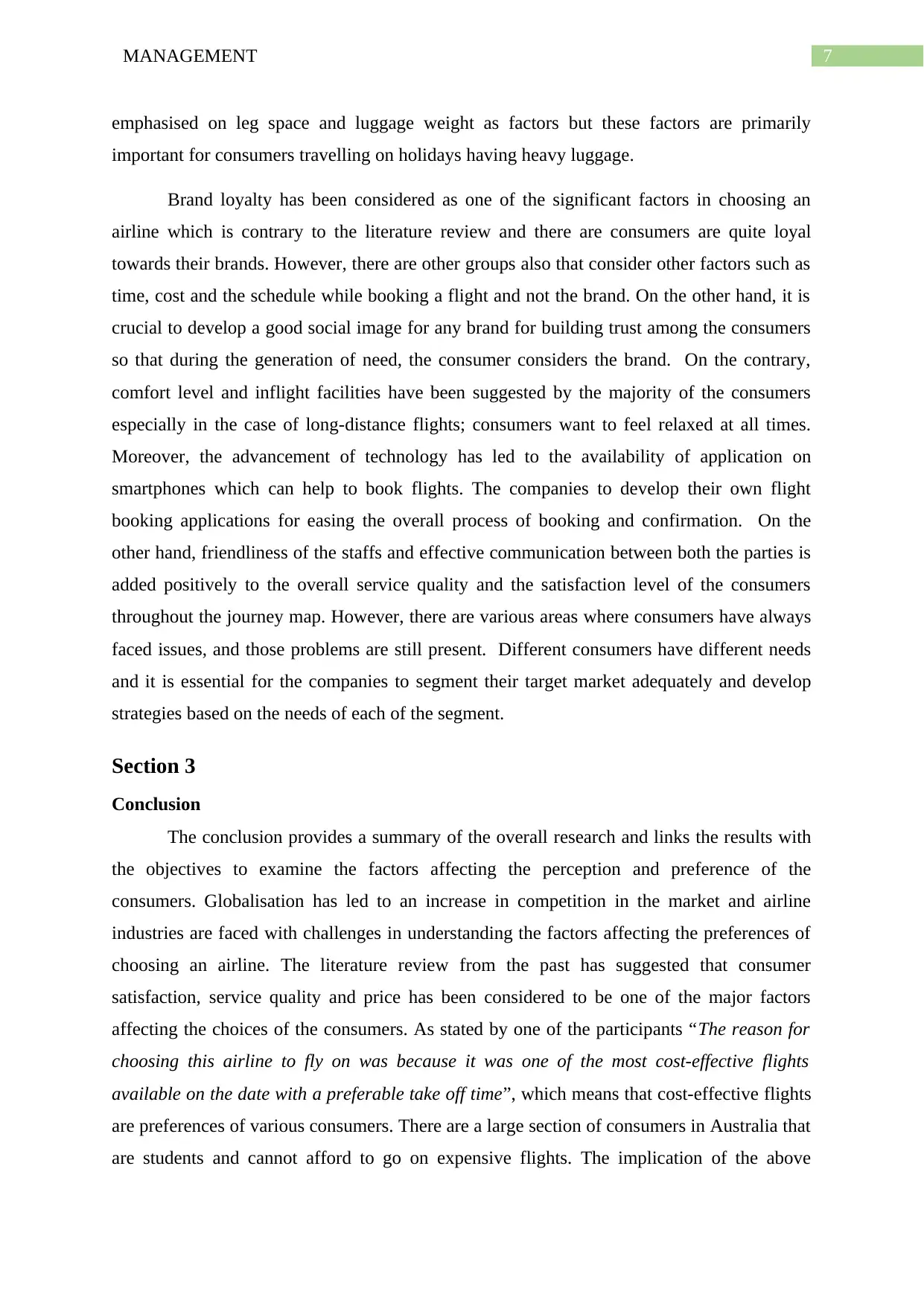
7MANAGEMENT
emphasised on leg space and luggage weight as factors but these factors are primarily
important for consumers travelling on holidays having heavy luggage.
Brand loyalty has been considered as one of the significant factors in choosing an
airline which is contrary to the literature review and there are consumers are quite loyal
towards their brands. However, there are other groups also that consider other factors such as
time, cost and the schedule while booking a flight and not the brand. On the other hand, it is
crucial to develop a good social image for any brand for building trust among the consumers
so that during the generation of need, the consumer considers the brand. On the contrary,
comfort level and inflight facilities have been suggested by the majority of the consumers
especially in the case of long-distance flights; consumers want to feel relaxed at all times.
Moreover, the advancement of technology has led to the availability of application on
smartphones which can help to book flights. The companies to develop their own flight
booking applications for easing the overall process of booking and confirmation. On the
other hand, friendliness of the staffs and effective communication between both the parties is
added positively to the overall service quality and the satisfaction level of the consumers
throughout the journey map. However, there are various areas where consumers have always
faced issues, and those problems are still present. Different consumers have different needs
and it is essential for the companies to segment their target market adequately and develop
strategies based on the needs of each of the segment.
Section 3
Conclusion
The conclusion provides a summary of the overall research and links the results with
the objectives to examine the factors affecting the perception and preference of the
consumers. Globalisation has led to an increase in competition in the market and airline
industries are faced with challenges in understanding the factors affecting the preferences of
choosing an airline. The literature review from the past has suggested that consumer
satisfaction, service quality and price has been considered to be one of the major factors
affecting the choices of the consumers. As stated by one of the participants “The reason for
choosing this airline to fly on was because it was one of the most cost-effective flights
available on the date with a preferable take off time”, which means that cost-effective flights
are preferences of various consumers. There are a large section of consumers in Australia that
are students and cannot afford to go on expensive flights. The implication of the above
emphasised on leg space and luggage weight as factors but these factors are primarily
important for consumers travelling on holidays having heavy luggage.
Brand loyalty has been considered as one of the significant factors in choosing an
airline which is contrary to the literature review and there are consumers are quite loyal
towards their brands. However, there are other groups also that consider other factors such as
time, cost and the schedule while booking a flight and not the brand. On the other hand, it is
crucial to develop a good social image for any brand for building trust among the consumers
so that during the generation of need, the consumer considers the brand. On the contrary,
comfort level and inflight facilities have been suggested by the majority of the consumers
especially in the case of long-distance flights; consumers want to feel relaxed at all times.
Moreover, the advancement of technology has led to the availability of application on
smartphones which can help to book flights. The companies to develop their own flight
booking applications for easing the overall process of booking and confirmation. On the
other hand, friendliness of the staffs and effective communication between both the parties is
added positively to the overall service quality and the satisfaction level of the consumers
throughout the journey map. However, there are various areas where consumers have always
faced issues, and those problems are still present. Different consumers have different needs
and it is essential for the companies to segment their target market adequately and develop
strategies based on the needs of each of the segment.
Section 3
Conclusion
The conclusion provides a summary of the overall research and links the results with
the objectives to examine the factors affecting the perception and preference of the
consumers. Globalisation has led to an increase in competition in the market and airline
industries are faced with challenges in understanding the factors affecting the preferences of
choosing an airline. The literature review from the past has suggested that consumer
satisfaction, service quality and price has been considered to be one of the major factors
affecting the choices of the consumers. As stated by one of the participants “The reason for
choosing this airline to fly on was because it was one of the most cost-effective flights
available on the date with a preferable take off time”, which means that cost-effective flights
are preferences of various consumers. There are a large section of consumers in Australia that
are students and cannot afford to go on expensive flights. The implication of the above
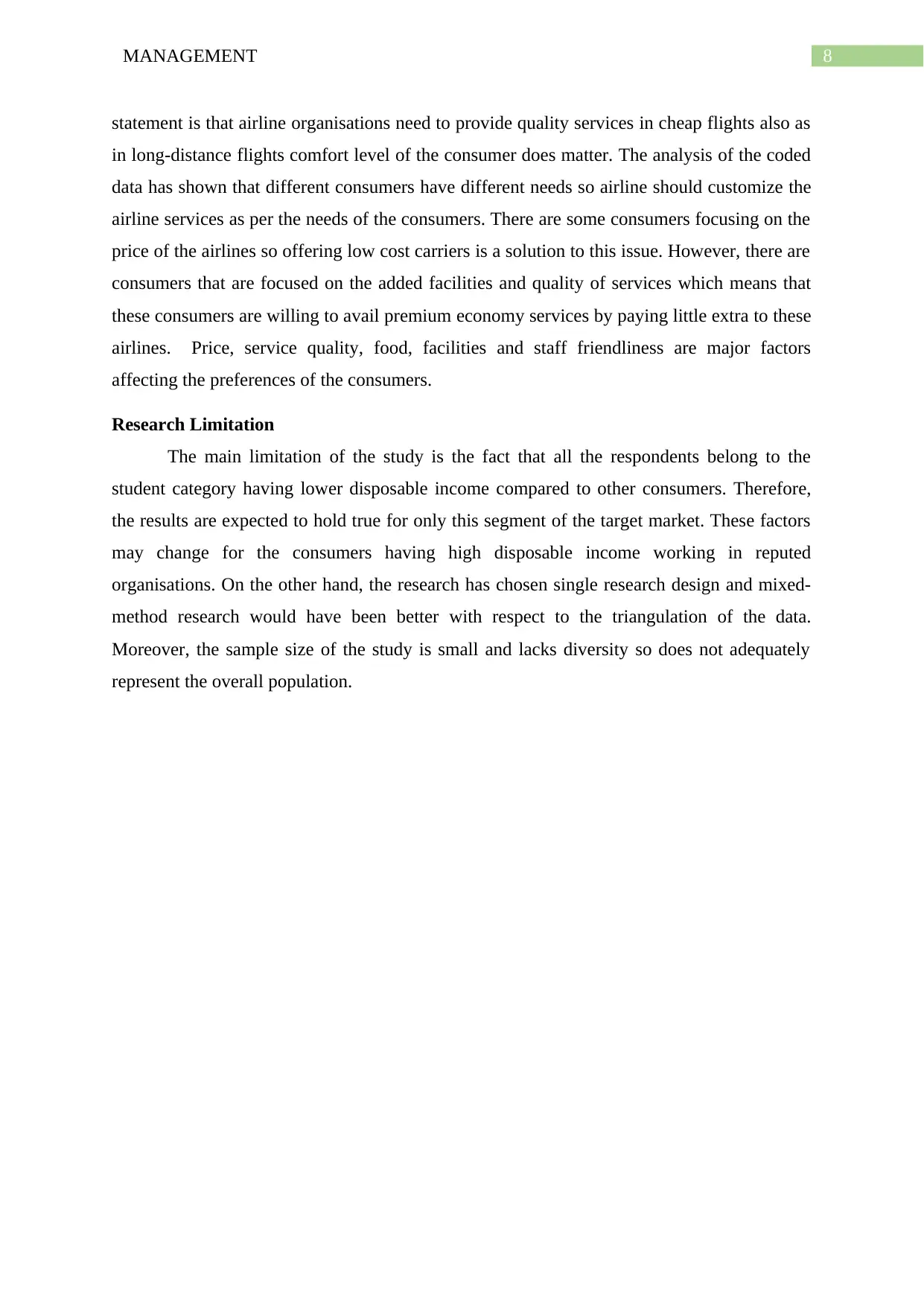
8MANAGEMENT
statement is that airline organisations need to provide quality services in cheap flights also as
in long-distance flights comfort level of the consumer does matter. The analysis of the coded
data has shown that different consumers have different needs so airline should customize the
airline services as per the needs of the consumers. There are some consumers focusing on the
price of the airlines so offering low cost carriers is a solution to this issue. However, there are
consumers that are focused on the added facilities and quality of services which means that
these consumers are willing to avail premium economy services by paying little extra to these
airlines. Price, service quality, food, facilities and staff friendliness are major factors
affecting the preferences of the consumers.
Research Limitation
The main limitation of the study is the fact that all the respondents belong to the
student category having lower disposable income compared to other consumers. Therefore,
the results are expected to hold true for only this segment of the target market. These factors
may change for the consumers having high disposable income working in reputed
organisations. On the other hand, the research has chosen single research design and mixed-
method research would have been better with respect to the triangulation of the data.
Moreover, the sample size of the study is small and lacks diversity so does not adequately
represent the overall population.
statement is that airline organisations need to provide quality services in cheap flights also as
in long-distance flights comfort level of the consumer does matter. The analysis of the coded
data has shown that different consumers have different needs so airline should customize the
airline services as per the needs of the consumers. There are some consumers focusing on the
price of the airlines so offering low cost carriers is a solution to this issue. However, there are
consumers that are focused on the added facilities and quality of services which means that
these consumers are willing to avail premium economy services by paying little extra to these
airlines. Price, service quality, food, facilities and staff friendliness are major factors
affecting the preferences of the consumers.
Research Limitation
The main limitation of the study is the fact that all the respondents belong to the
student category having lower disposable income compared to other consumers. Therefore,
the results are expected to hold true for only this segment of the target market. These factors
may change for the consumers having high disposable income working in reputed
organisations. On the other hand, the research has chosen single research design and mixed-
method research would have been better with respect to the triangulation of the data.
Moreover, the sample size of the study is small and lacks diversity so does not adequately
represent the overall population.
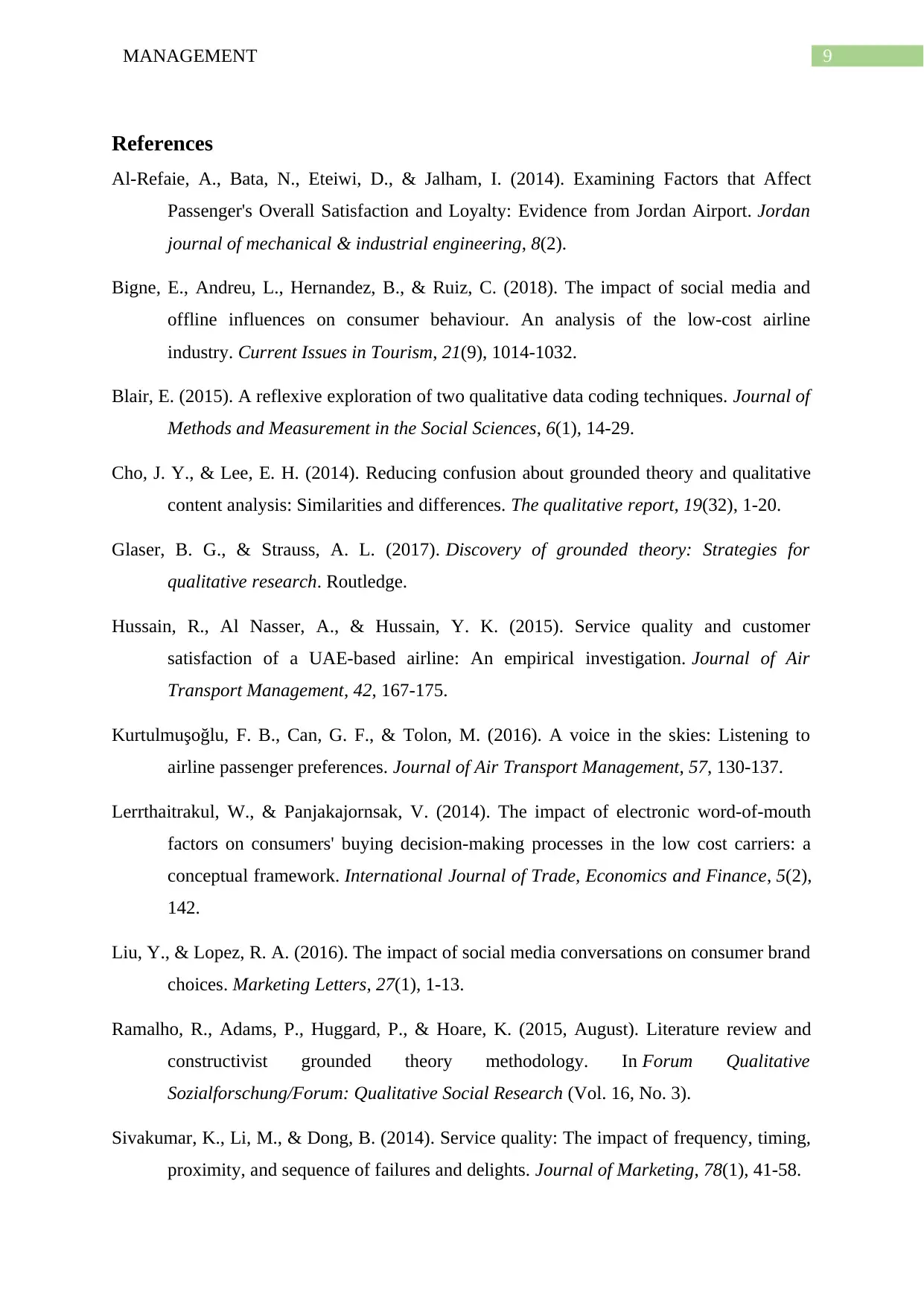
9MANAGEMENT
References
Al-Refaie, A., Bata, N., Eteiwi, D., & Jalham, I. (2014). Examining Factors that Affect
Passenger's Overall Satisfaction and Loyalty: Evidence from Jordan Airport. Jordan
journal of mechanical & industrial engineering, 8(2).
Bigne, E., Andreu, L., Hernandez, B., & Ruiz, C. (2018). The impact of social media and
offline influences on consumer behaviour. An analysis of the low-cost airline
industry. Current Issues in Tourism, 21(9), 1014-1032.
Blair, E. (2015). A reflexive exploration of two qualitative data coding techniques. Journal of
Methods and Measurement in the Social Sciences, 6(1), 14-29.
Cho, J. Y., & Lee, E. H. (2014). Reducing confusion about grounded theory and qualitative
content analysis: Similarities and differences. The qualitative report, 19(32), 1-20.
Glaser, B. G., & Strauss, A. L. (2017). Discovery of grounded theory: Strategies for
qualitative research. Routledge.
Hussain, R., Al Nasser, A., & Hussain, Y. K. (2015). Service quality and customer
satisfaction of a UAE-based airline: An empirical investigation. Journal of Air
Transport Management, 42, 167-175.
Kurtulmuşoğlu, F. B., Can, G. F., & Tolon, M. (2016). A voice in the skies: Listening to
airline passenger preferences. Journal of Air Transport Management, 57, 130-137.
Lerrthaitrakul, W., & Panjakajornsak, V. (2014). The impact of electronic word-of-mouth
factors on consumers' buying decision-making processes in the low cost carriers: a
conceptual framework. International Journal of Trade, Economics and Finance, 5(2),
142.
Liu, Y., & Lopez, R. A. (2016). The impact of social media conversations on consumer brand
choices. Marketing Letters, 27(1), 1-13.
Ramalho, R., Adams, P., Huggard, P., & Hoare, K. (2015, August). Literature review and
constructivist grounded theory methodology. In Forum Qualitative
Sozialforschung/Forum: Qualitative Social Research (Vol. 16, No. 3).
Sivakumar, K., Li, M., & Dong, B. (2014). Service quality: The impact of frequency, timing,
proximity, and sequence of failures and delights. Journal of Marketing, 78(1), 41-58.
References
Al-Refaie, A., Bata, N., Eteiwi, D., & Jalham, I. (2014). Examining Factors that Affect
Passenger's Overall Satisfaction and Loyalty: Evidence from Jordan Airport. Jordan
journal of mechanical & industrial engineering, 8(2).
Bigne, E., Andreu, L., Hernandez, B., & Ruiz, C. (2018). The impact of social media and
offline influences on consumer behaviour. An analysis of the low-cost airline
industry. Current Issues in Tourism, 21(9), 1014-1032.
Blair, E. (2015). A reflexive exploration of two qualitative data coding techniques. Journal of
Methods and Measurement in the Social Sciences, 6(1), 14-29.
Cho, J. Y., & Lee, E. H. (2014). Reducing confusion about grounded theory and qualitative
content analysis: Similarities and differences. The qualitative report, 19(32), 1-20.
Glaser, B. G., & Strauss, A. L. (2017). Discovery of grounded theory: Strategies for
qualitative research. Routledge.
Hussain, R., Al Nasser, A., & Hussain, Y. K. (2015). Service quality and customer
satisfaction of a UAE-based airline: An empirical investigation. Journal of Air
Transport Management, 42, 167-175.
Kurtulmuşoğlu, F. B., Can, G. F., & Tolon, M. (2016). A voice in the skies: Listening to
airline passenger preferences. Journal of Air Transport Management, 57, 130-137.
Lerrthaitrakul, W., & Panjakajornsak, V. (2014). The impact of electronic word-of-mouth
factors on consumers' buying decision-making processes in the low cost carriers: a
conceptual framework. International Journal of Trade, Economics and Finance, 5(2),
142.
Liu, Y., & Lopez, R. A. (2016). The impact of social media conversations on consumer brand
choices. Marketing Letters, 27(1), 1-13.
Ramalho, R., Adams, P., Huggard, P., & Hoare, K. (2015, August). Literature review and
constructivist grounded theory methodology. In Forum Qualitative
Sozialforschung/Forum: Qualitative Social Research (Vol. 16, No. 3).
Sivakumar, K., Li, M., & Dong, B. (2014). Service quality: The impact of frequency, timing,
proximity, and sequence of failures and delights. Journal of Marketing, 78(1), 41-58.
Secure Best Marks with AI Grader
Need help grading? Try our AI Grader for instant feedback on your assignments.
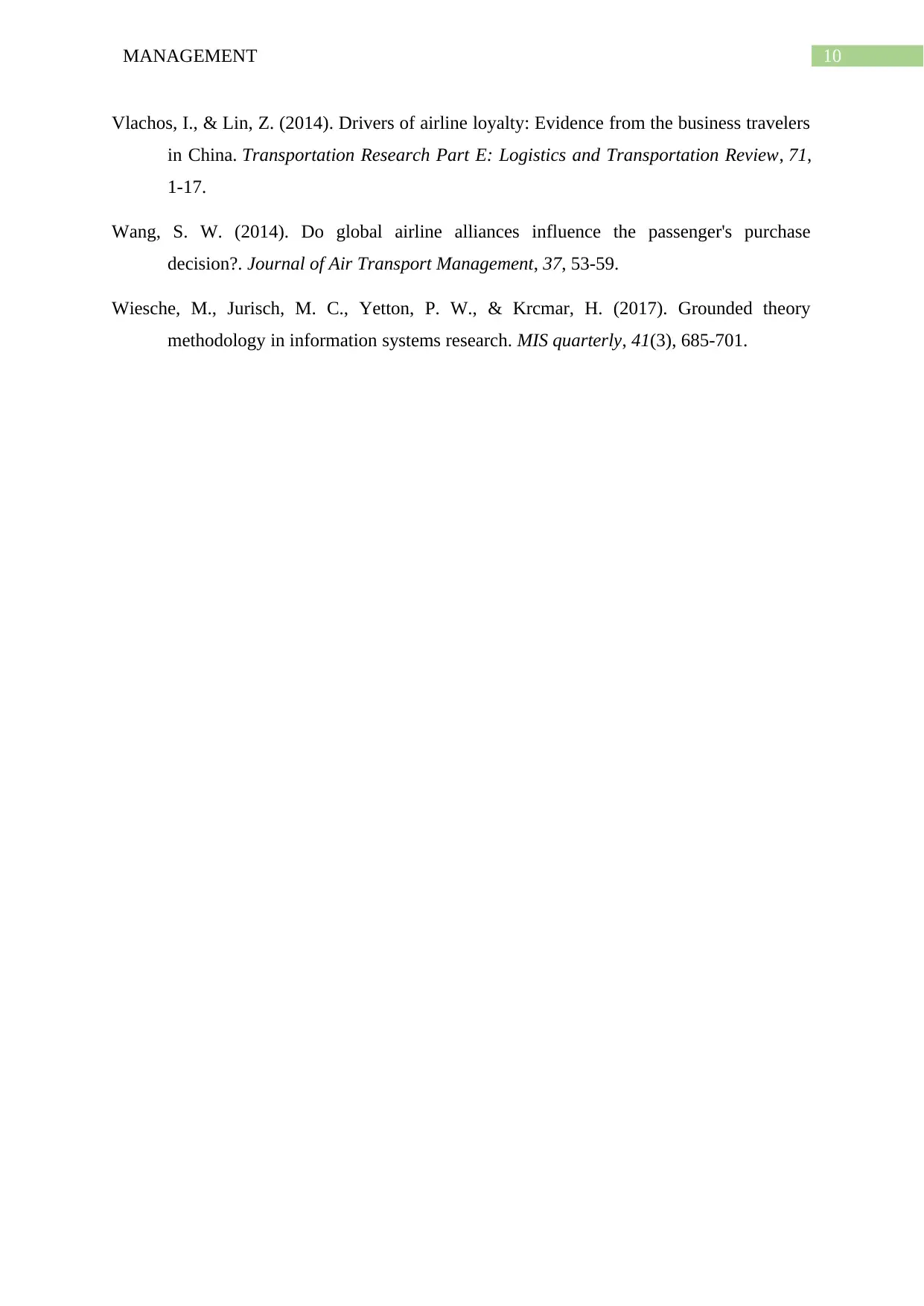
10MANAGEMENT
Vlachos, I., & Lin, Z. (2014). Drivers of airline loyalty: Evidence from the business travelers
in China. Transportation Research Part E: Logistics and Transportation Review, 71,
1-17.
Wang, S. W. (2014). Do global airline alliances influence the passenger's purchase
decision?. Journal of Air Transport Management, 37, 53-59.
Wiesche, M., Jurisch, M. C., Yetton, P. W., & Krcmar, H. (2017). Grounded theory
methodology in information systems research. MIS quarterly, 41(3), 685-701.
Vlachos, I., & Lin, Z. (2014). Drivers of airline loyalty: Evidence from the business travelers
in China. Transportation Research Part E: Logistics and Transportation Review, 71,
1-17.
Wang, S. W. (2014). Do global airline alliances influence the passenger's purchase
decision?. Journal of Air Transport Management, 37, 53-59.
Wiesche, M., Jurisch, M. C., Yetton, P. W., & Krcmar, H. (2017). Grounded theory
methodology in information systems research. MIS quarterly, 41(3), 685-701.
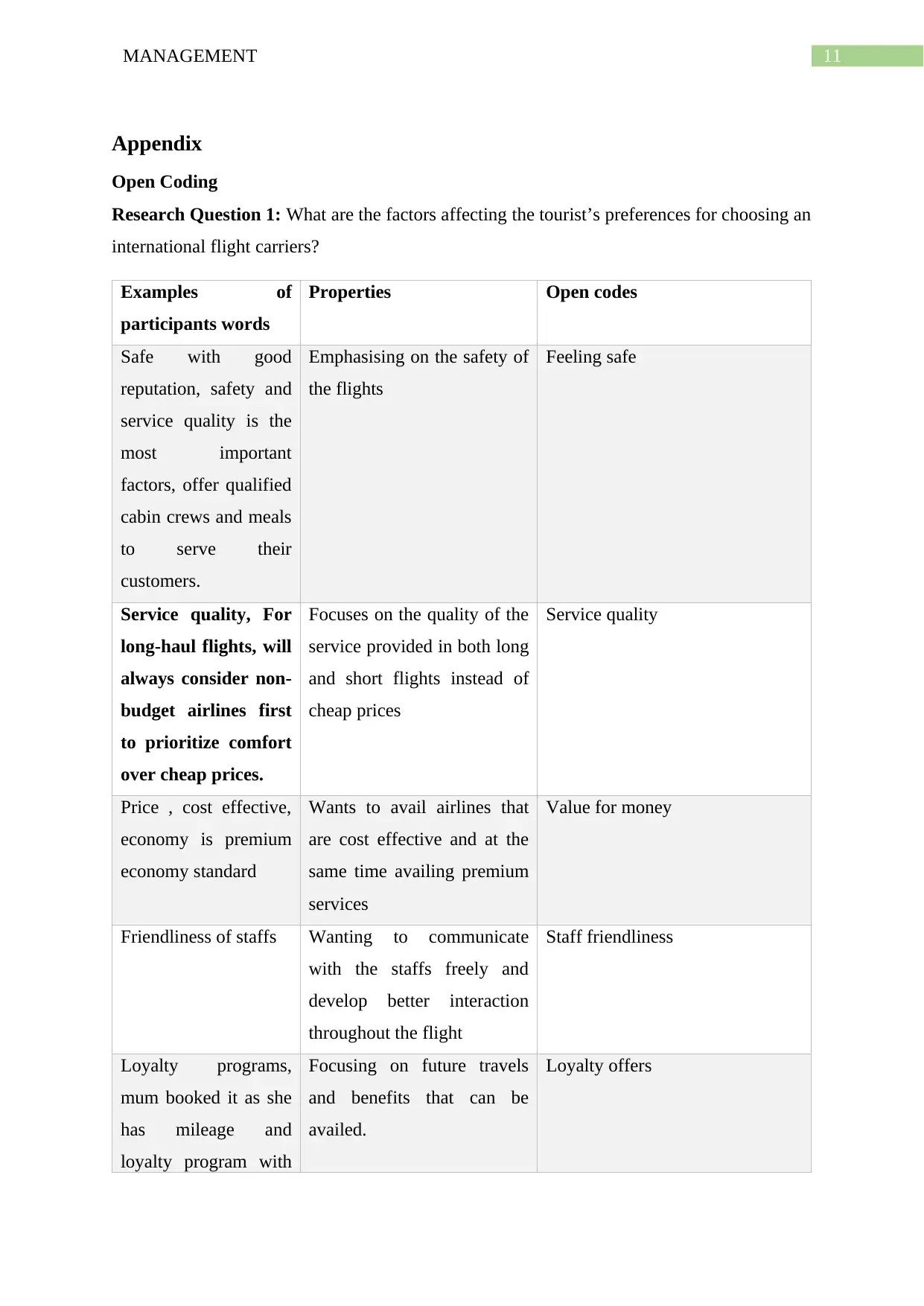
11MANAGEMENT
Appendix
Open Coding
Research Question 1: What are the factors affecting the tourist’s preferences for choosing an
international flight carriers?
Examples of
participants words
Properties Open codes
Safe with good
reputation, safety and
service quality is the
most important
factors, offer qualified
cabin crews and meals
to serve their
customers.
Emphasising on the safety of
the flights
Feeling safe
Service quality, For
long-haul flights, will
always consider non-
budget airlines first
to prioritize comfort
over cheap prices.
Focuses on the quality of the
service provided in both long
and short flights instead of
cheap prices
Service quality
Price , cost effective,
economy is premium
economy standard
Wants to avail airlines that
are cost effective and at the
same time availing premium
services
Value for money
Friendliness of staffs Wanting to communicate
with the staffs freely and
develop better interaction
throughout the flight
Staff friendliness
Loyalty programs,
mum booked it as she
has mileage and
loyalty program with
Focusing on future travels
and benefits that can be
availed.
Loyalty offers
Appendix
Open Coding
Research Question 1: What are the factors affecting the tourist’s preferences for choosing an
international flight carriers?
Examples of
participants words
Properties Open codes
Safe with good
reputation, safety and
service quality is the
most important
factors, offer qualified
cabin crews and meals
to serve their
customers.
Emphasising on the safety of
the flights
Feeling safe
Service quality, For
long-haul flights, will
always consider non-
budget airlines first
to prioritize comfort
over cheap prices.
Focuses on the quality of the
service provided in both long
and short flights instead of
cheap prices
Service quality
Price , cost effective,
economy is premium
economy standard
Wants to avail airlines that
are cost effective and at the
same time availing premium
services
Value for money
Friendliness of staffs Wanting to communicate
with the staffs freely and
develop better interaction
throughout the flight
Staff friendliness
Loyalty programs,
mum booked it as she
has mileage and
loyalty program with
Focusing on future travels
and benefits that can be
availed.
Loyalty offers
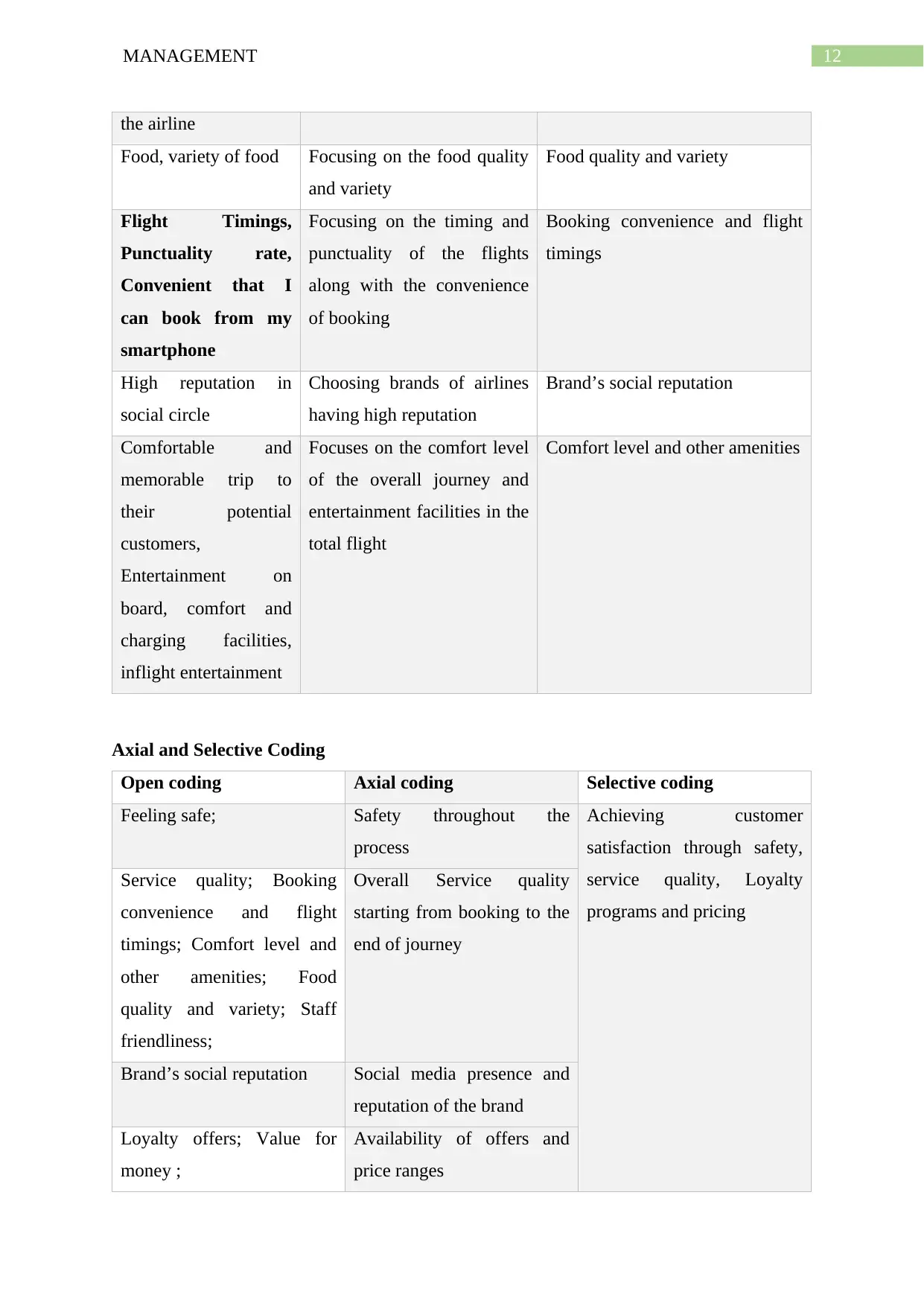
12MANAGEMENT
the airline
Food, variety of food Focusing on the food quality
and variety
Food quality and variety
Flight Timings,
Punctuality rate,
Convenient that I
can book from my
smartphone
Focusing on the timing and
punctuality of the flights
along with the convenience
of booking
Booking convenience and flight
timings
High reputation in
social circle
Choosing brands of airlines
having high reputation
Brand’s social reputation
Comfortable and
memorable trip to
their potential
customers,
Entertainment on
board, comfort and
charging facilities,
inflight entertainment
Focuses on the comfort level
of the overall journey and
entertainment facilities in the
total flight
Comfort level and other amenities
Axial and Selective Coding
Open coding Axial coding Selective coding
Feeling safe; Safety throughout the
process
Achieving customer
satisfaction through safety,
service quality, Loyalty
programs and pricing
Service quality; Booking
convenience and flight
timings; Comfort level and
other amenities; Food
quality and variety; Staff
friendliness;
Overall Service quality
starting from booking to the
end of journey
Brand’s social reputation Social media presence and
reputation of the brand
Loyalty offers; Value for
money ;
Availability of offers and
price ranges
the airline
Food, variety of food Focusing on the food quality
and variety
Food quality and variety
Flight Timings,
Punctuality rate,
Convenient that I
can book from my
smartphone
Focusing on the timing and
punctuality of the flights
along with the convenience
of booking
Booking convenience and flight
timings
High reputation in
social circle
Choosing brands of airlines
having high reputation
Brand’s social reputation
Comfortable and
memorable trip to
their potential
customers,
Entertainment on
board, comfort and
charging facilities,
inflight entertainment
Focuses on the comfort level
of the overall journey and
entertainment facilities in the
total flight
Comfort level and other amenities
Axial and Selective Coding
Open coding Axial coding Selective coding
Feeling safe; Safety throughout the
process
Achieving customer
satisfaction through safety,
service quality, Loyalty
programs and pricing
Service quality; Booking
convenience and flight
timings; Comfort level and
other amenities; Food
quality and variety; Staff
friendliness;
Overall Service quality
starting from booking to the
end of journey
Brand’s social reputation Social media presence and
reputation of the brand
Loyalty offers; Value for
money ;
Availability of offers and
price ranges
Paraphrase This Document
Need a fresh take? Get an instant paraphrase of this document with our AI Paraphraser

13MANAGEMENT
1 out of 14
Related Documents
Your All-in-One AI-Powered Toolkit for Academic Success.
+13062052269
info@desklib.com
Available 24*7 on WhatsApp / Email
![[object Object]](/_next/static/media/star-bottom.7253800d.svg)
Unlock your academic potential
© 2024 | Zucol Services PVT LTD | All rights reserved.





